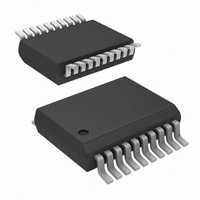ISL6884IAZ Intersil, ISL6884IAZ Datasheet - Page 11

ISL6884IAZ
Manufacturer Part Number
ISL6884IAZ
Description
IC CTRLR CCFL BRIGHTNESS 20-SSOP
Manufacturer
Intersil
Datasheet
1.ISL6884IAZ.pdf
(13 pages)
Specifications of ISL6884IAZ
Display Type
CCFL - Cold Cathode Fluorescent Lamp
Interface
I²C
Voltage - Supply
4.5 V ~ 5.5 V
Operating Temperature
-40°C ~ 85°C
Mounting Type
Surface Mount
Package / Case
20-SSOP
Lead Free Status / RoHS Status
Lead free / RoHS Compliant
Current - Supply
-
Configuration
-
Digits Or Characters
-
Available stocks
Company
Part Number
Manufacturer
Quantity
Price
Company:
Part Number:
ISL6884IAZ
Manufacturer:
Intersil
Quantity:
480
I
Introduction
(Refer to Philips I
The I
circuits. I
formal name Inter-Integrated-Circuit bus. The 2 wires are the
SCL (Serial CLock) and SDA (Serial DAta). All ICs on the
bus are connected to the SCL and SDA lines. SCL and SDA
pins on each device are bidirectional and can act as either
inputs or open drain outputs. Which device is transmitting
and receiving is determined by the bus protocol which will be
described below.
A typical I
communication (usually a microprocessor) and one or more
‘slaves’ that respond to commands from the master. Each
slave has a device address. In a typical communication
sequence, the master will initiate communication with a ‘start
condition’ followed by the address of one of the slave
devices. The slave device must acknowledge that it
recognizes its address. After receiving the acknowledge, the
master will transmit one or more bytes of commands and
data. If the slave device is an EEPROM the command is the
address within the EEPROM that is to be read or written. If
data is to be written to the EEPROM the master transmits it
after the command.
START and STOP Conditions
As shown in Figure 1, START condition is a HIGH to LOW
transition of the SDA line while SCL is HIGH.
The STOP condition is a LOW to HIGH transition on the SDA
line while SCL is HIGH. A STOP condition must be sent
before each START condition.
2
SDA
SCL
C Bus General Description
CPU
CONDITION
2
START
C bus is a 2 wire communication bus for integrated
S
I2C Master
2
FIGURE 1. START AND STOP WAVEFORMS
2
C, I2C or IIC are commonly used instead of the
control
control
C bus system is made of a ‘master’ that initiates
SCL
SDA
input
output
input
output
2
C Specification, Rev. 2.1)
VDD
slave devices
to other
11
output
output
output
output
input
input
input
input
I2C Slave
I2C Slave
control
control
control
control
SDA
SDA
SCL
SCL
CONDITION
STOP
machine,
registers,
machine,
registers,
memory,
memory,
P
state
state
etc.
etc.
ISL6884
START
SDA
SCL
Data Validity
The data on the SDA line must be stable during the HIGH
period of the clock. The HIGH or LOW state of the data line
can only change when the clock signal on the SCL line is
LOW. Refer to Figure 2.
Byte Format
Every byte put on the SDA line must be eight bits long. The
number of bytes that can be transmitted per transfer is
unrestricted. Each byte has to be followed by an
acknowledge bit. Data is transferred with the most significant
bit first (MSB).
Acknowledge
The master (microprocessor) puts a resistive HIGH level on
the SDA line during the acknowledge clock pulse (Figure 3).
The peripheral that acknowledges has to pull down (LOW)
the SDA line during the acknowledge clock pulse, so that the
SDA line is stable LOW during this clock pulse. (Of course,
set-up and hold times must also be taken into account.)
The peripheral which has been addressed has to generate
an acknowledge after the reception of each byte, otherwise
the SDA line remains at the HIGH level during the ninth
clock pulse time. In this case, the master transmitter can
generate the STOP information in order to abort the transfer.
SDA
SCL
FIGURE 3. ACKNOWLEDGE ON THE I
MSB
1
DATA VALID
DATA LINE
STABLE
FIGURE 2. DATA VALIDITY
ALLOWED
CHANGE
OF DATA
2
8
2
C BUS
ACKNOWLEDGE
FROM SLAVE
March 9, 2006
9
FN9265.0





